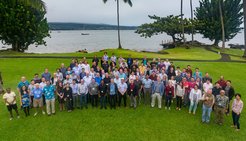Honour for the Event Horizon Telescope (EHT)
The 2021 Royal Astronomical Society Group Achievement Award goes to the EHT Project
The Event Horizon Telescope (EHT) collaboration is excited for having been granted by the Royal Astronomical Society (RAS) with the 2021 Group Achievement Award (A). The EHT is a global network of synchronised radio observatories that work in unison to observe radio sources associated with black holes.
In April 2019, the EHT team showed the world the first image of the shadow cast by the black hole in M87, made possible by the enormous baselines which give the EHT its exquisite angular resolution.

Participants of the EHT Collaboration Meeting in Hilo/Hawaii in December 2019.
The RAS citation statement, made public on January 8th, 2021, reads: "this image has already inspired millions and will continue to do so. It represents an important milestone in human ingenuity and scientific endeavour, and is opening new doorways to study the physics of accretion around super-massive black holes in completely unprecedented ways." Furthermore, "the realisation of the EHT represented a formidable challenge and was made possible only by decades of hard work and commitment by thirteen stakeholder institutions, a variety of agencies, and more than three hundred forty researchers. This is one of the finest examples of an achievement resulting from close collaboration by researchers from around the World."
The members of the EHT are honoured by this distinction that the RAS awards in order to recognize outstanding achievements by large consortia in any branch of astronomy. Among the previous winners are the Planck Team and the LIGO Team. For its unparalleled precise observations, the EHT combines the power of existing telescopes that can observe at millimetre wavelength around the world, including the ALMA interferometer in the Chilean Andes that is operated in a joint global collaboration.
“The first picture of a Black Hole only became possible because many researchers and institutions contributed their talents and resources," says Anton Zensus, Founding Chair of the EHT Collaboration Board and Director at the Max-Planck-Institut für Radioastronomie. "With its Group Award, the Royal Astronomical Society, one of the oldest and most prestigious Scientific Societies in the World, is paying tribute to this extraordinary team effort."
The EHT Project Director, Huib van Langevelde, states: "we are thrilled that our work on imaging of the event horizon regions in super-massive black holes, at the edge of technology and achieving extreme resolutions in astronomy gets such a recognition from this renowned institution; it is an inspiration to our team to deliver more, fundamental scientific results on black holes".
------------------------------------
Background Information:
EHT Telescopes: The individual telescopes involved in the EHT collaboration are at present: ALMA, APEX, the IRAM 30-meter Telescope, the IRAM NOEMA Observatory (expected 2021), the Kitt Peak Telescope (expected 2021), the James Clerk Maxwell Telescope (JCMT), the Large Millimeter Telescope (LMT), the Submillimeter Array (SMA), the Submillimeter Telescope (SMT), the South Pole Telescope (SPT), and the Greenland Telescope (GLT, since 2018).
EHT Consortium: The EHT consortium consists of 13 stakeholder institutes; the Academia Sinica Institute of Astronomy and Astrophysics, the University of Arizona, the University of Chicago, the East Asian Observatory, Goethe-Universität Frankfurt, Institut de Radioastronomie Millimétrique, Large Millimeter Telescope, Max-Planck-Institut für Radioastronomie, MIT Haystack Observatory, National Astronomical Observatory of Japan, Perimeter Institute for Theoretical Physics, Radboud University and the Smithsonian Astrophysical Observatory.
